Pain in your toe or the ball of your foot – Metatarsalgia
Pain in your toe or the ball of your foot – Metatarsalgia
What is Metatarsalgia?
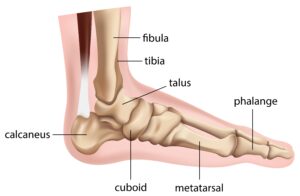
Metatarsalgia is pain in the ball of your foot, specifically in the area of the metatarsal bones.
There are group of conditions that can cause pain and inflammation around the bones and joints in the ball of the foot. The most common cause is from a sudden increase in pressure or activity resulting in micro trauma and inflammation.
Around 80 percent of the population experience this pain at some point in life and finding comfortable footwear can be difficult. We encourage you to try the self help exercises below for this common condition before contacting the podiatry team.
Signs and symptoms of Metatarsalgia
You may experience any or all of these symptoms:
- a sharp, stabbing, burning or tingling sensation affecting the ball of the foot and into the toes
- pain that increases with weight bearing activity and improves with rest
- sensation of walking on a `pebble’ or `lump’
- increased pain when walking barefoot, especially on a hard surface.
Common conditions causing pain in the ball of your foot
The most common conditions affecting and causing pain in the ball of the foot are:
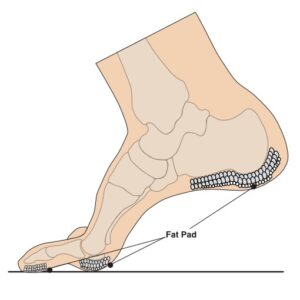 Fat pad atrophy – thinning and degeneration of the fat pad – the soft tissue layer between the skin and bones under the ball of your foot. The fat pad helps with shock absorption and spreading of pressure across the ball of your foot during activity.
Fat pad atrophy – thinning and degeneration of the fat pad – the soft tissue layer between the skin and bones under the ball of your foot. The fat pad helps with shock absorption and spreading of pressure across the ball of your foot during activity.
Thinning of the fat pad can lead to reduced shock absorption, making the foot more vulnerable to repetitive micro-trauma and developing inflammation, bruising, swelling and pain.
Thinning of the fat pad is a natural process and begins around the age of 30. It can take several years before the fat pad becomes thin enough to cause pain to develop. Fat pad atrophy is more common in people with Diabetes.
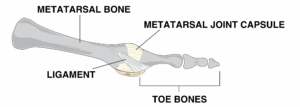 Capsulitis – a term used to describe inflammation of a joint capsule, the covering that surrounds a joint. In your foot it most commonly affects the joint next to the big toe but can affect any joint within the body.
Capsulitis – a term used to describe inflammation of a joint capsule, the covering that surrounds a joint. In your foot it most commonly affects the joint next to the big toe but can affect any joint within the body.
The capsule consists of a thick outer layer for strength and a thinner synovial layer producing fluid to lubricate the joint. Micro trauma or damage to the joint capsule can result in excess fluid being produced which causes the joint to swell and become painful when bearing weight.
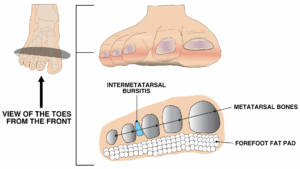 Intermetatarsal bursitis – an inflammation of one of the bursa between the joints in the ball of the foot. The bursas are small sacs of fluid that help increase shock absorption and reduce friction, preventing bones from rubbing together.
Intermetatarsal bursitis – an inflammation of one of the bursa between the joints in the ball of the foot. The bursas are small sacs of fluid that help increase shock absorption and reduce friction, preventing bones from rubbing together.
When the bursa becomes inflamed it can swell and become painful when weight bearing. Tight fitting shoes can increase the compression of the bursa resulting in pain.
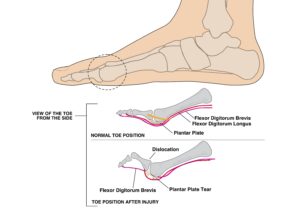 Plantar plate injury – also known as plantar plate tear, involves damage to a strong ligament in the foot called the plantar plate.
Plantar plate injury – also known as plantar plate tear, involves damage to a strong ligament in the foot called the plantar plate.
These deep ligaments form the bottom part of the joint capsule within each of the joints in the ball of the foot.
The plantar plates help to stabilize the foot and toes when weight bearing and also provide the attachment of the plantar fascia into the base of the toes.
Repeated micro trauma can lead to tearing or partial tearing of the plantar plate. If left untreated this can cause deformity of the affected toe.
Other factors contributing to pain in the ball of the foot:
- being over-weight
- age – the fat pad under the ball of the foot becomes thinner and this can increase pressure at the front of the foot
- increased swelling in feet
- high arched feet
- tightness in the muscles in the back of the leg
- weakness within the muscles in your foot/leg
- unsuitable footwear that is too narrow or has a thin sole, such as high heeled shoe
- foot deformities such as hallux valgus (bunion), hallux limitus and hammer toe deformities
- inflammatory conditions such as rheumatoid or psoriatic arthritis
- previous foot trauma, such as a metatarsal fracture or nerve injury
- spending long periods standing, walking or running, especially with a sudden increase in these activities.
What can I do to relieve pain in the ball of my foot?
Unfortunately there is no quick or easy fix and your symptoms won’t improve overnight.
If you have any of the contributing factors listed above, it’s important that you make changes to your lifestyle and reduce aggravating activities to help your recovery. Only you can do this.
To reduce pressure and inflammation around the affected joints, it’s important to consider your footwear and decreasing any tightness in the calf muscles, which can increase the pressures through the front of your foot. Your pain should improve but may take time to get better.
Things to try:
- raising your foot on a stool and resting it when you can
- putting an ice pack (or bag of frozen peas) in a towel on the painful area for up to 20 minutes every two to three hours
- shoes with cushioned heels and good arch support
- insoles in your footwear
- regular stretching and foot exercises
- exercises which put no pressure on your feet, such as swimming
- losing weight if you’re overweight or obese.
Things to avoid:
- walking or standing for long periods
- wearing high heels or tight, pointy shoes
- wearing flip-flops or backless slippers
- walking barefoot on hard surfaces.
What shoes should I wear if I have pain in the ball of my foot?
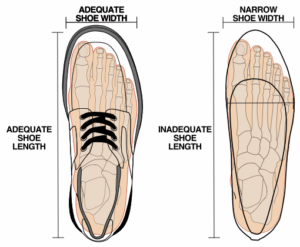 It’s important to make sure your footwear fits well and is not too tight across the fore foot. Narrow footwear will increase compression through the joints and increase your pain. Shoes with a deep and wide toe box are preferable.
It’s important to make sure your footwear fits well and is not too tight across the fore foot. Narrow footwear will increase compression through the joints and increase your pain. Shoes with a deep and wide toe box are preferable.
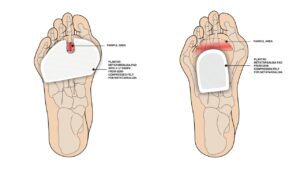 Padding
Padding
Padding can be applied to the bottom of the foot or on an insole, to help cushion and reduce the pressure on the joints. Padding comes in a variety of materials and can be bought from your local pharmacy or online.
Find out more on our footwear advice page including how to check if shoes fit.
Ankle, foot and toe rehabilitation exercises
The video exercises shown below will help to improve your pain over a period of time. Watch the video first, then try the exercise. There are six videos to try – go through to the next one below by clicking the arrow on the right of the video. All videos provided and shared with kind permission of, and thanks to, the Musculoskeletal Podiatry team at NHS Lanarkshire.
You need the use of a clear space of wall, a small towel, a small plastic bottle of water, a sports resistance band and a sports therapy ball. If you do not have a sports resistance band or sports therapy ball (also known as a soft spiked massage ball) these can be purchased relatively inexpensively online. If cost is an issue, focus on the exercises which do not use that equipment.
Important – pain levels: the NHS uses a pain scale where pain is measured from 0-10 (zero being no pain and 10 representing the worst pain you could imagine).
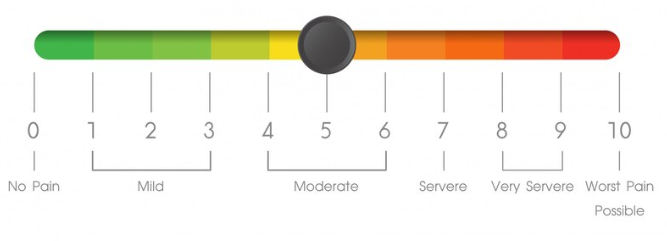
If you can identify the level of pain you are experiencing, you will find out if you are in the green, amber or red zone.
When you are completing your rehabilitation exercises it is often best to work within the green (and sometimes amber zones depending on what you deem is an acceptable level of pain) both during the exercises and within 48 hours of completing your exercises.
The best way to move down to the green zone is by pacing and spacing your activity. If you find yourself in the red zone you are likely pushing yourself too hard and the pain may flare up.
If you notice a large increase in your pain after doing the exercises, or you find that after six to twelve weeks there is no noticeable changes in your day to day symptoms, then please contact your GP or self-refer to our MSK podiatry team.